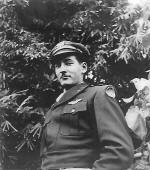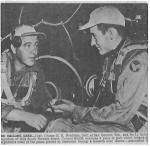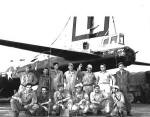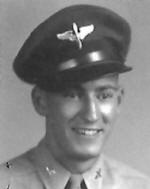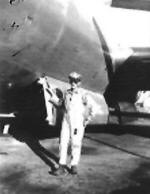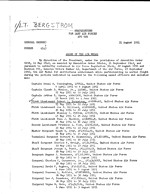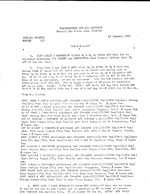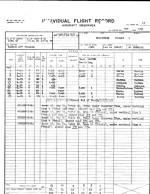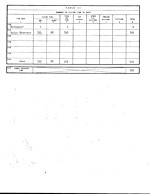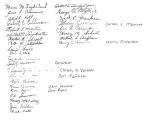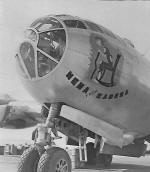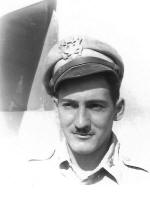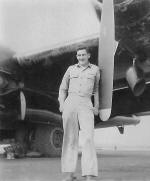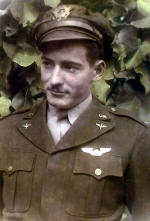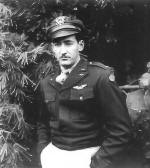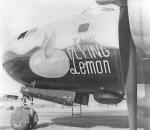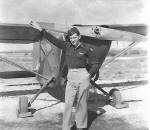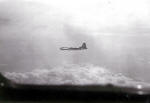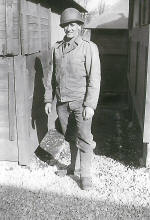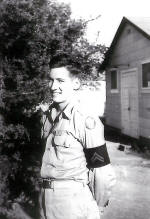|
We need your help to keep the KWE online. This website
runs on outdated technology. We need to migrate this website to a modern
platform, which also will be easier to navigate and maintain. If you value this resource and want to honor our veterans by keeping their stories online
in the future, please donate now.
For more information, click here.
|
|||||||||||||||
 |
|||||||||||||||
| Back to "Memoirs" Index page | |||||||||||||||
Robert L. BergstromBock, Minnesota - "To be truthful, it is not easy for me to relive that day, especially these last few years. Maybe I should have told my story over and over again. Some say it is good therapy to tell it and write about it. Maybe it is. There were times I didn't even want to look at a B-29. Even if a picture was put before me, it brought back too many memories." - Bob Bergstrom
|
|||||||||||||||
Memoir Contents:ForewordI finally sat down and made an effort to write my story as I remember it over "Namsi." As I have been reading Black Tuesday Over Namsi, I realize the many years of trying to gather information and putting it all together. I have come to understand why it was not possible for the Korean War Educator to find Captain Lewis' crew--or any of us. It wasn't many days before we were flying missions again. We made ten missions after "Black Tuesday Over Namsi." They were night missions by "Shoran." They finally told us that replacements were coming and we would be going home. We were slated to go by commercial air. (No parachutes, of course--I didn't care for that! I am sure I had the stewardess flustered and was glad when we landed in San Francisco. At the airport they told us they would fly us anywhere we wanted--just come up and sign the manifest. I called home and told them I was taking the train. I didn't want to fly. After a couple weeks at home, the Air Force was training me in B-29's at Barksdale Air Force Base, and I was slated to go to Morraco, Africa. The General called me in and said I was up for getting my Captaincy and they wanted me to stay in he Air Force. I had made up my mind to be discharged, so I made my salute and about-face and left for home. I often thought over the years that if I had had more R&R and had stayed in the Air Force, where I would be today. "No Regrets." I met my spouse, had four children, and made our future going to Africa (the "Congo") as missionaries for twenty years before retiring in 1991. In my retiring years I now realize some of the mistakes I have made. Looking back a few months at my health issues, I needed some help with dental work. I went to the VA thinking I would get some help. They immediately said, looking at my records and seeing that I only had 70 percent service connected, "They couldn't help." I needed 100 percent. I was really disappointed. Thinking about it, my "mistake" was not going to the dispensary for my arm wound upon returning from the Namsi mission. Even the next day others told me that I would have received a Purple Heart. I have heard that all who were given Purple Hearts got 100 percent service connected when discharged. I wonder? Also, over the years I cannot believe that the Air Force never gave our crew (Captain Lewis' crew) any recognition with either a Distinguished Flying Cross or an Air Medal. I realize we were never interviewed, but maybe in all that was going on at the time it just got overlooked. I wouldn't now know who to turn to, if anyone. Actually, I don't know why I am telling you all this--maybe I just needed to get it off my chest. Many have told me that I am entitled to full benefits at the V.A. One thing is fore sure. If it wasn't for my "Faith in God," and my wife helping me through some rough times with my "invisible wounds," I don't think I would have made it. Too Many MemoriesI have had a hard time writing about what happened to me and the crew on the 23rd of October 1951, known as "Black Tuesday Over Namsi." Listening to the Far East Radio the night before and hearing what happened to the 19th Bombardment Wing didn't help our getting ready to make the same type mission the next day on Namsi. Nevertheless, we got up early for the briefing, loaded on the 6x6 army truck, saying very little, if anything, to each other out to our plane. To be truthful, it is not easy for me to relive that day, especially these last few years. Maybe I should have told my story over and over again. Some say it is good therapy to tell it and write about it. Maybe it is. There were times I didn't even want to look at a B-29. Even if a picture was put before me, it brought back too many memories. I seem to be better since I have been interviewed and written up in the local newspaper. After my neighbor read the story, she came and asked me if I've ever contacted any of my crew members. I had to say I hadn't. It got me to looking up my Air Force records I've kept for years in a trunk in our attic. Before this time, I was having trouble sleeping nights because I was reliving my combat missions. Under the advice of a veteran friend, I contacted the Veterans Administration. On my first visit, as I began to tell my store, the psychologist said, "We want to help you." I was diagnosed as having Post Traumatic Stress Disorder (PTSD) and was recommended to have some 20 sessions. It did help to a degree, but I was told that, in the end, my invisible wounds will be with me the rest of my life. They did say that I can always call back because new things come out that maybe could help. Joining UpI reported to Fort Snelling, Minnesota, the 5th of January 1944 for active duty. My brother had already volunteered and was serving in the Navy Air Corps flight training at Purdue University Air Field in Indiana. I decided to go down and ask him what I should do. I was 17 years old at the time. Talking it over with my folks, I took a bus down to see him. Arriving at the airport, I went up to the guard. "What can I do for you?" he asked. I said, "I am here to see my brother. He is here in flight training. I am from Bock, Minnesota. Can I see him?" He turned and after a moment said, "You go into those doors and wait there. He will come out in that room." I did, and sure enough, it wasn't long before he showed up. It was good to see him. We talked a while and, of course, he had classes and went flying. I took some pictures out on the flight line. I finally asked him what he thought I should do. His advice to me was, "The Navy is really hard. Why not try the Army Air Corps?" At the same time, he asked me, "How is it you are able to get in here, for NOBODY is allowed in this airport other than Navy personnel." I told him, "I just told them that I'm from Bock, Minnesota and I came to see my brother, and they let me in. I must have looked okay." After returning home to our farm, I right away went down to the barn where my dad was finishing up milking the cows. I told him that I had decided to join the Army Air Corps. My dad thought a little and then he said, "I guess the way things are going with the country, if I was your age I would join too. I told my mother and she said, "One in the service is enough." I was able to overcome that with a little convincing. One Hurdle After AnotherNow it was off to take tests in St. Paul, Minnesota to see if I would qualify for cadet training. I remember there were 270 questions on the test and I got 247 correct. The one giving the test said, "That was really good." That was my first hurtle. After some basic training I had to take more tests for a week. I found out later that it had nothing to do with flying, but was given to see if I was able to be taught in future training and to determine what would be best for me in the different areas available in the Air Corps. Then I was told that I needed some college education to allow me to go into cadet training. They sent me to Oklahoma A & M in Stillwater, Oklahoma for about a three-month crash course. It was hard, but I passed and was on my way. Diary of a Navigator-in-TrainingBefore entering college training I was sent to Garden City, Kansas for my first flights in the air. The following is from a few pages of the diary that I kept at that time.
Black TuesdayPlanning the MissionA lot of planning went into getting ready for this mission. As I remember, the weather was not the greatest. That meant we had to be ready to drop our bombs electronically by what was known as SHORAN. SHORAN is an acronym for SHOrt RAnge Navigation, a type of electronic navigation and bombing system with a precision radar beacon. I was the radar operator and I was checked out in this type of operation. Under daylight or visual conditions, flying SHORAN, using only an arc on the screen for guidance, with a slightly level formation for some 60 miles to the target didn't appeal to me. Really, we were sitting ducks. The trip was uneventful up the initial point (I.P.), but, as suspected, weather conditions were such that we were forced to go electronic SHORAN on the bomb run. In the beginning all three flights seemed to be in formation. This changed when we started on the bomb run. Able and Baker flights stayed together. We were in Able flight Number 2--Captain Lewis' right wing, with Captain Kruman on the left. There was some disagreement, so we heard Charlie's flight dropped behind a couple miles. On to the TargetWe were now decompressurized, so we had our oxygen masks on. I always set my regulator to 100%. I felt better with that setting. On the run to the target, Namsi Air Field, we encountered the most flak I have ever experienced. On other missions I heard flak bounce off the plane, but never like this. It seemed to be bigger stuff and more accurate. Right at this time a cloud of insulation was spread all over the rear of the plane and over all of my radar equipment. Where it came from, I couldn't tell. We found out later that it came from the tunnel that is connected over the bomb bay. It seemed like everything was happening at the same time with flak penetrating under the floorboard by my feet. I began to hear a crackling noise and smoke. I knew immediately what it was because it had happened to me on another mission. I pulled the board loose and could see that the wires that came from my radar equipment had been hit. With my gloves on my hands I quickly spread the wires to stop it from smoking and catching on fire. I left the board off to see if there would be any more smoke. I looked at my radar screen and SHORAN. They weren't functioning. I got on the intercom to let the bombardier know what happened. Right after that I felt a little something in my left arm. On examination I found out that it was some blood, but I didn't think it was too bad. I wrapped it up with my hanky as tight as I could and forgot about it. Then more flak--big stuff--hit. The gunner's right side blister was gone. Later he told me he raised up when it was shot off and he hit his head on something. It drew a little blood, but he felt okay too. Time was passing. I knew that it was getting close to "bombs away". It seemed that the flak had stopped. We knew MiGs were coming at us by the noise of the gunners shooting. We then heard that Captain Krumon's aircraft was hit and its number two engine was on fire and the crew had to abort. Over the intercom came, "Watch for any chutes." We saw two chutes before they went into the clouds. I kept watching the gunners I could see from my position, continually glancing to make sure that no fire or smoke was coming from my radar equipment. All this time the gunners were calling over the intercom. I heard the tail gunner, Webb, say he got one MiG. I think other gunners were getting hits also. During this time I heard, "Bombs away!" I thought that now Captain Lewis would be doing what we called "evasive action", but we were still flying straight and level. It seemed like an eternity to me before making a left-hand turn to head south to the 38th parallel. We were still under fighter attacks. Captain Lewis knew what needed to be done--stay in formation--watching Able Lead (Captain Fogler's plane) before making our move to descend. The actual battle lasted about fifteen minutes. I thought it was much longer than that. We found later that three of the nine B-29s went down in flames. Brave MiG PilotFinally in our descent and out of harm's way, I remember standing up, saying, "Thank you, God." Tears shot out of my eyes. That never had happened to me before or since. It just seemed like the MiGs were never going to stop coming at us. Right then the right-side gunner, Brugeman, waved to me to see what he was looking at. I went over and saw a MiG-15 flying just to our right. I was so surprised. I wish that one of us had had a camera. He flew alongside of us for about a minute. Finally we both waved to each other and he peeled off. Over the years I have wondered how brave he was to take a chance to do that. Assessing DamageGetting to a lower altitude, we took off our oxygen masks and began to assess our damage. The flight engineer said we still had all four engines functioning, but our hydraulic system was out. We had to think about winding down our landing gears. At this time Captain Lewis decided to call the Air-Sea Rescue to follow us back to Okinawa in case of any more trouble. We made sure that we had a crank to wind down the gear. We knew it was in the forward bomb bay on the right side. We heard later that it took 741 turns. The gunner, Brugeman, volunteered to do the job. I went along to help and change off. Captain Lewis said we will wait to wind down the gear about an hour before landing. He also decided to give each of the crew the option to bail out when we got over the airfield, not knowing if the gear would hold. We all decided to stay with the plane. The Air-Sea Rescue plane flew under us and checked the gear the best its pilot could. He thought it looked okay. Too Many Holes to CountCaptain Lewis did a great job landing. We all sweated it out with him. A photographer was there to take a picture of the crew and plane. Others came to check us out too. I heard the next day that there were too many holes to count, along with a cannon hole below the vertical stabilizer between me and ahead of the tail gunner. A person could have squeezed through that big hole. They said this plane would just be used for parts. I never counted the holes either. We naturally had our debriefing. It took a couple of hours to tell them all the information we could. After debriefing we were ready to hit the sack. The log book showed 10 hours and 45 minutes flying time. I'm amazed that we made it with the flak holes and the cannon hole in the rear, not hitting a more fatal part of the plane or crew. There were no gas leaks. I guess the self-sealing fuel tanks really worked. After looking around the next morning, I realized that some of my buddies were not coming back. That was not easy to erase from my mind. Now when I'm asked to tell my story I try to let people know and never forget the ultimate sacrifice that many have given--their lives--so that we can enjoy the freedom we have here in America. Other MissionsYou might ask, "What about your arm?" I didn't mention it during the debriefing. Why? I thought about it, but I didn't want to be taken off flying status. If we had to do more missions, I wanted to go with the crew. We had a good crew that worked well together. It meant a lot to me. I made five more missions in November and five in December. They were all night missions by SHORAN. During one mission we had to land at Itazuke, Japan, to get something repaired before returning back to Okinawa. I remember that another mission was all the way up to Antung, an airfield in Manchuria. They used searchlights at our altitude. I had to steer out of the searchlights and then get back to the SHORAN again before "bombs away." We think we made a good hit and then Captain Lewis did evasive action and hooked onto the jet stream to get a faster run home. It took a lot of working together to accomplish the mission. I made a total of 39 combat missions. About the AuthorRobert Bergstrom was born in Karlstad, Minnesota on November 2, 1925, a son of Oscar and Julia Jensen Bergstrom. He moved with his family to Bock, Minnesota, in 1930 and resides there in 2018. After graduating from Milaca High School, Bergstrom made a trip to Purdue, Indiana, to ask his brother Maurice Emanuel Bergstrom (1924-2009)for advice. Maurice served in the U.S. Navy Air Corps from 1943 to 1946. His brother advised him to join the Army Air Corps. He began his cadet training corps at age 18, and was commissioned and earned his wings at the age of 19. After his initial radar operator training he was sent to California where he studied bombers and radar before being shipped to Okinawa as a pilot near the end of World War II. Among his early experiences as a radar operator was flying his plane over the bomb sites of Nagasaki and Hiroshima, Japan. The plane had a special filter attached so he could check the radiation levels while flying over the two cities. After the mission the filter was sent to the Pentagon. His next assignment was a top secret project mapping by radar all of North Korea and the northern-most island off of Japan. According to Bergstrom, this project led him to believe that there was another war coming just around the corner. (He was right.) He was allowed to go home, but was soon called back to duty in a telegram from President Truman. He reported for duty at an Air Force base in Illinois, and was then sent to Shreveport, Louisiana, for a six-week refresher course. After that he was sent to Okinawa. When the Korean War broke out, Bergstrom was sent on some 39 missions in B-29s. These planes had four motors, 144 bombs weighing 100 pounds each, 6,000 gallons of fuel, two pilots, and a crew of ten assigned to various duties. Robert received his honorable discharge in 1952 with two oak leaf clusters in air medals and became a carpenter. He married nurse Erma Johnson, a Foley High School graduate, on October 23, 1965. The couple had four children, and traveled as missionaries to the Congo. Besides carpentry and ministry, Robert has been a bee-keeper, tended to Red Angus cows, and operated a sawmill. His children are all college graduates. The Lewis Crew (B-29 tail #44-87760)
The PlaneThis B-29 (tail number 44-87760) was one of nine B-29s dispatched to attack Namsi Airfield at Sinuiju, North Korea on October 23, 1951. Three of the nine planes were shot down, with 44-87760 being the only one that made it back to base at Kadena Air Field, Okinawa. The remaining planes landed in Seoul, Korea and returned to Kadena AFB later. All eleven crew members of Lewis' plane survived and were assigned to 371st Bomb Squadron, 307th Bomb Group, MacDill AFB, Florida. After that the plane was re-assigned to 343rd Bomb Squadron, 98th Bomb Group, Spokane AFB, Washington. It was reclaimed as scrap and components at Tinker AFB, Oklahoma, 8 August 1954.
|
|||||||||||||||
Photo Gallery(Click a picture for a larger view) |
|||||||||||||||
|
|||||||||||||||
 |
|||||||||||||||



